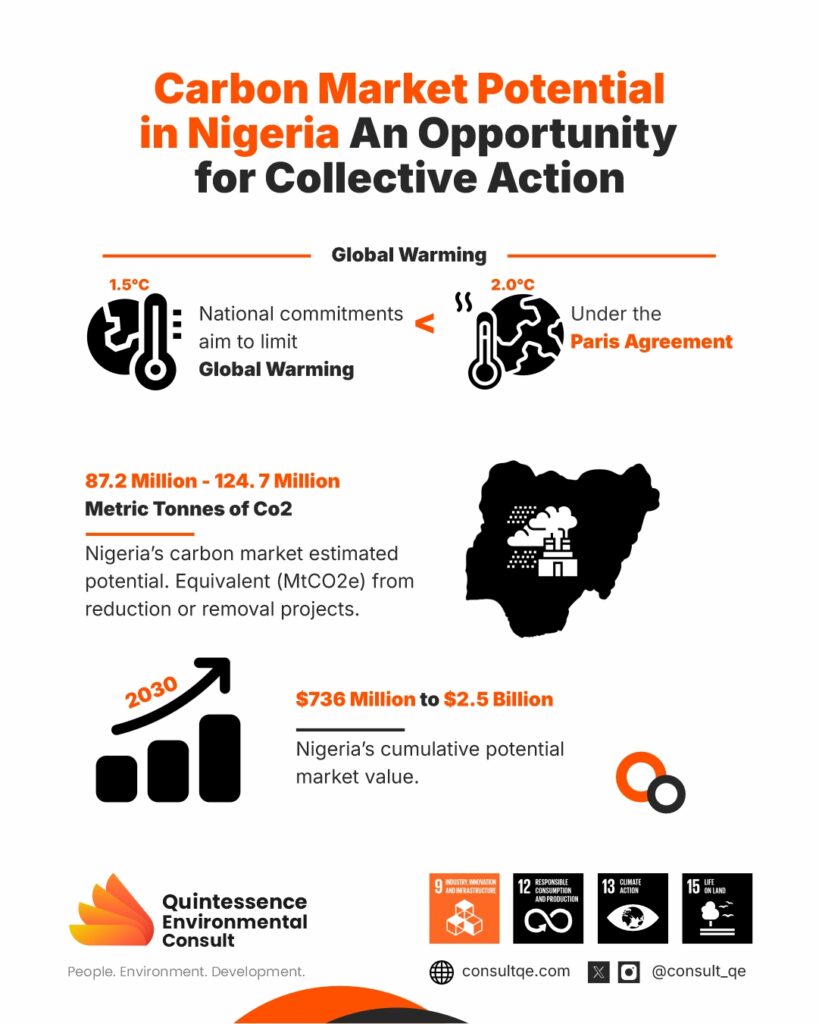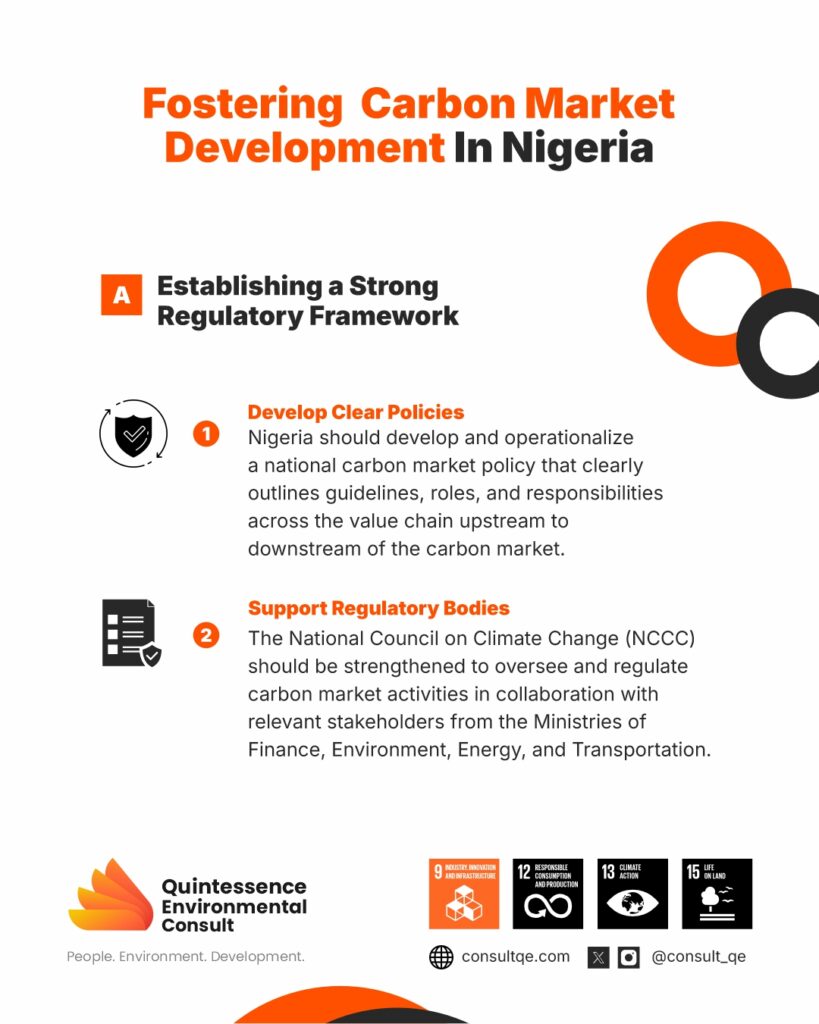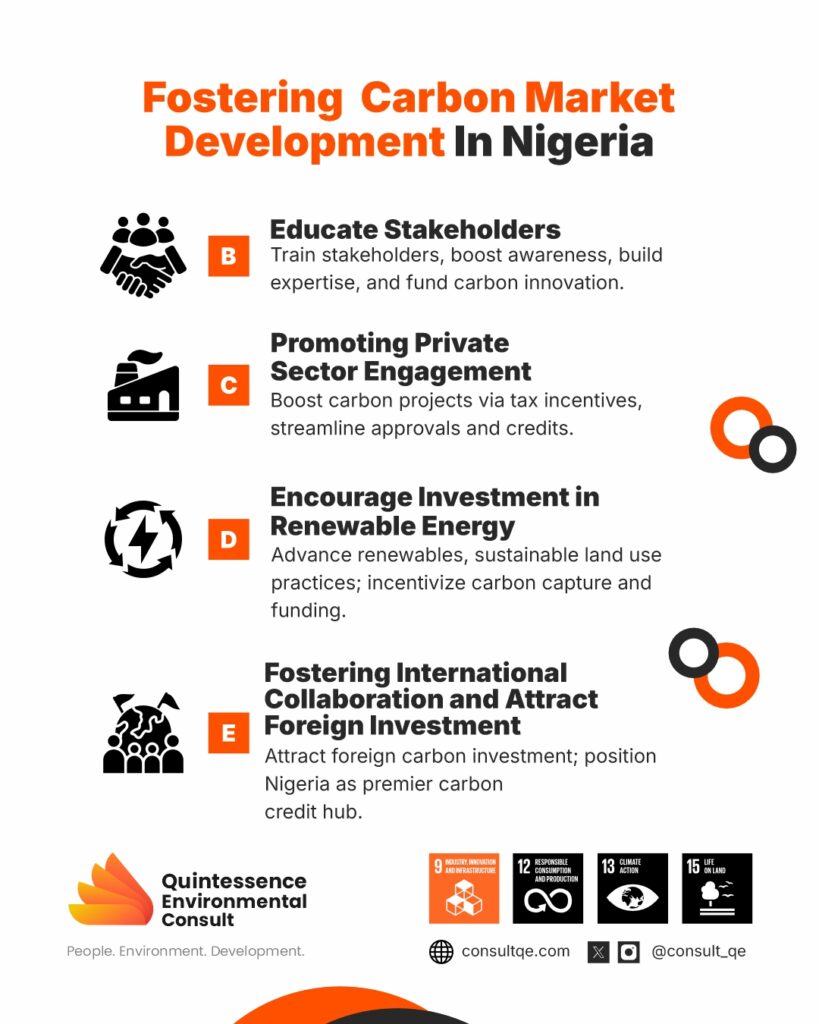KEY TAKEAWAYS
- Nigeria’s carbon market potential is estimated at 87.2 to 124.7 million metric tonnes of CO2 equivalent (MtCO2e) from reduction or removal projects.
- The cumulative potential market value is projected to be between 736 million USD and 2.5 billion USD by 2030.
- Despite wide challenges in setting up and operationalizing a carbon market system, several opportunities for advancement abound for various stakeholders through participation, collaboration and commercialization of services.
- The carbon market supports innovative climate adaptation projects, fostering research and innovation.
- Governments, companies, and individuals can actively participate in the carbon market system as either regulators, project developers, investors, researchers, carbon removal monitors and others.
INTRODUCTION
Nigeria has a carbon market potential of 87.2 to 124.7 MtCO2e (metric tons of carbon dioxide equivalent) that could be achieved from removal or reduction projects. In addition, Nigeria’s cumulative carbon market potential value stands between 736 million and 2.5 billion USD by 2030. But what exactly is the carbon market and what role can you play in it?
The carbon market ecosystem is a market-based system that promotes the trade of carbon credits to incentivize the reduction of greenhouse gas emissions. The idea is to create a market system that advances global efforts to reduce GHG emissions. These emissions are generally quantified into carbon credits, which can be bought and sold. The metric for measurement is that one tradable carbon is equivalent to one metric tonne of CO2 or other greenhouse gases that are reduced, sequestered or avoided.
Effectively, a carbon credit is an emission permit for a specified amount of carbon dioxide (CO2) or other greenhouse gases (GHGs). For every one credit, you can release into the atmosphere one metric ton (2204 pounds) of CO2 or an equivalent amount of another GHG. Carbon credits can be purchased by countries as part of their Nationally Determined Contributions (NDC) strategy, by corporations with sustainability targets, and by private individuals looking to compensate for their carbon footprint.
Another means of promoting emission reductions is through carbon offsetting. Unlike carbon credits (which represent a “cap” on permissible emissions), carbon offsets represent emissions that have been “removed” from the atmosphere, either through natural sequestration or technological reduction projects. From a regulatory standpoint, there is no use case for purchasing carbon offsets from a voluntary market. However, this does not mean they are not useful or valuable; they may, after all, increase in value making them an interesting, emerging asset class.

EMISSIONS TRADING AND CARBON MARKETS
Carbon markets are a carbon pricing mechanism, facilitating State and non-State actors to trade greenhouse gas emissions. The carbon market initiative aims to drive climate action targets and facilitate cost-effective climate transition programs. The carbon market scheme is classified into two categories namely;
- The Regulatory Compliance Market
The compliance market otherwise known as the compliance carbon market (RCM) is used by companies and governments that are legally required to account for their GHG emissions. It is regulated by mandatory national, regional or international carbon reduction regimes. Accordingly, in compliance markets such as national or regional emissions trading systems (ETS) participants act in response to an obligation established by a regulatory body. The CCM primarily works based on a cap-and-trade system regulated by the Government, setting a specific cap on emissions in a particular region or sector.
- The Voluntary Market
In voluntary carbon markets (VCM), there is no binding obligation on participants such as companies or individuals, but these non-State actors seek to offset their emissions voluntarily. The VCM is driven by the recognition that national commitments to cut greenhouse gas (GHG) emissions to meet the requirements of the Paris Agreement of limiting global warming to 1.50 C and no more than 2.00 C is not promising.
Key Components of the Carbon Market
- Project Developers: These entities create projects that reduce or sequester GHGs, such as reforestation, renewable energy, or energy efficiency projects.
- Verification and Certification: Independent third parties verify and certify that the projects are indeed reducing GHGs and issue carbon credits accordingly.
- Registries: Carbon registries track the issuance, ownership, and retirement of carbon credits. They provide transparency and prevent double counting of emission reductions.
- Carbon Credit Buyers: These include companies and individuals who purchase carbon credits to offset their emissions. They can be part of mandatory compliance markets or voluntary markets. For instance, international airline operators participating in the Carbon Offsetting and Reduction Scheme for International Aviation (CORSIA) offset their CO2 emissions above a baseline level
- Regulators and Governments: They set the rules and regulations for compliance markets, ensuring that industries adhere to emission caps. Governments or international bodies, such as the European Union Emissions Trading System (EU ETS), run and regulate these markets.
- Brokers: These entities facilitate the buying and selling of carbon credits. They provide platforms for trading and ensure transparency and efficiency in the market.
- Investors and Financial Institutions: They provide the necessary capital for developing carbon reduction projects. Hedge funds, banks, and other financial institutions are increasingly active in the carbon market.
- Marketplaces: Platforms where buyers and sellers can trade carbon credits. Examples include the Verified Carbon Standard (VCS) and the Gold Standard.
- Startups & Research Institutions: These are entities that create innovations in the system for monitoring, tracking, verification and modelling GHG emissions, as well as support marketplace exchanges.

MAJOR CHALLENGES IN ESTABLISHING AND OPERATIONALIZING CARBON MARKETS
Amidst all the hype, it is important to note that realizing carbon credits within the global carbon market systems is fraught with challenges. Nevertheless, these issues present unique opportunities for advancement through participation, collaboration and commercialization for a wide range of stakeholders.
For example, the need for regulatory frameworks and operational manuals to guide the federal, state and local governments in light of the limited technical expertise highlights a huge prospect for consulting opportunities.
Furthermore, the issue of integrity and credibility of green projects where additionality, double counting, permanence and leakages are critical to meeting global standards in carbon emissions tracking, underscore the need for research and innovation. Reliable measurement, reporting and verification systems (MRV) support the claim for high-quality emission reductions. The potential benefits in the short, medium and long term are immense.

FOSTERING THE CARBON MARKET DEVELOPMENT IN NIGERIA
A careful look at the carbon market ecosystem shows that it is a robust and dynamic system that requires varying protocols, institutional frameworks, expertise and roles to function effectively and achieve its mission. These opportunities for developing countries especially in Africa and Nigeria in particular are enormous.
Fostering a robust carbon market system in Nigeria requires a rigorous multi-faceted approach, relying on the actions and involvement of the government, private sector, academia and international partners. Some key strategies include the following:
A. Establishing a Strong Regulatory Framework
- Develop Clear Policies:
Nigeria must develop and operationalize a national carbon market policy that clearly outlines guidelines, roles, and responsibilities across the value chain from upstream to downstream of the carbon market. This policy should also facilitate the active participation of Nigeria’s subnational entities. The Nigeria Carbon Market Activation Policy (NCMAP) is a very important step in this direction which has been supported by the work of the Inter-Governmental Committee on the Carbon Market Activation Plan chaired by the Chairman of the Federal Inland Revenue Service (FIRS). The committee has completed the development of the carbon market activation policy and produced the manual of procedures that shall guide Nigeria’s participation in the international market.
2. Support Regulatory Bodies:
The National Council on Climate Change (NCCC) should be strengthened to oversee and regulate carbon market activities in collaboration with relevant stakeholders from the Ministries of Finance, Environment, Energy, and Transportation. This is necessary to establish clear guidelines for project development, monitoring, reporting, and verification (MRV).
B. Educate Stakeholders
Conduct workshops and training programs to educate government officials, businesses, and communities about carbon markets. In addition, raise public awareness about the benefits of carbon market participation. Similarly, the subnational government should invest in building the local expertise of the staff of their relevant ministries departments and agencies on carbon market project development, MRV, and carbon finance.
C. Promoting Private Sector Engagement
Nigeria’s carbon market policy has to incentivize carbon reduction projects by providing financial incentives, such as tax breaks and subsidies, for businesses that invest in carbon reduction projects. Similarly, the project approval and carbon credit issuance process should be streamlined to reduce local bureaucracies.
D. Encourage Investment in Renewable Energy and Other Green Projects
A shift towards sustainable energy, agriculture (crop and livestock) and land use through strategic financial instruments is fundamental to achieving the net-zero target. Critical investments should be designed to promote the development of renewable energy projects, such as solar and wind power, which can generate carbon credits. In addition, sustainable forestry and agriculture practices should be designed to establish mechanisms that reward farmers and landowners for their carbon sequestration efforts.
E. Fostering International Collaboration and Attract Foreign Investment
The carbon market system supported by Article 6 of the Paris Climate Agreement is undoubtedly an international framework that must be understood in that context. Securing climate finance instruments, trading carbon and meeting nationally determined contributions is a multilateral engagement that cannot be achieved without international cooperation and collaboration.
This further makes the case for a strong National Council on Climate Change in Nigeria as highlighted in the Climate Change Act of 2021 Act. Accordingly, Nigeria’s climate change policy should facilitate a favorable investment climate to attract foreign investment in carbon reduction projects. Additionally, strong regulations should ensure that Nigeria is a destination for high-quality carbon credits.
CONCLUSION
In conclusion, this blog aims to elucidate the various components of the carbon market ecosystem and the opportunities thereof for various stakeholders. It also describes some of the key issues around establishing and operationalizing a vibrant carbon market in Nigeria.
So far, the Nigerian government is moving in the right direction with exceptional work being done by the NCCC and the intergovernmental committee on the carbon market activation. Nigeria’s cumulative carbon market potential value which is projected to be 2.5 billion USD by 2030 represents a huge financial incentive for action.
Overall, the carbon market supports innovative climate adaptation projects, fostering research and innovation and encouraging investment in sustainable projects. Governments, companies, and individuals can actively participate in the trade in a carbon market system as regulators, project developers, investors, researchers, carbon removal monitors and others. The time to act is now!
References
Corporate Finance Institute (CFI): Carbon Offsets. https://corporatefinanceinstitute.com/resources/esg/carbon-offsets/
Carbon Markets- Which type exist and how they work: https://www.fao.org/4/i1632e/i1632e02.pdf



